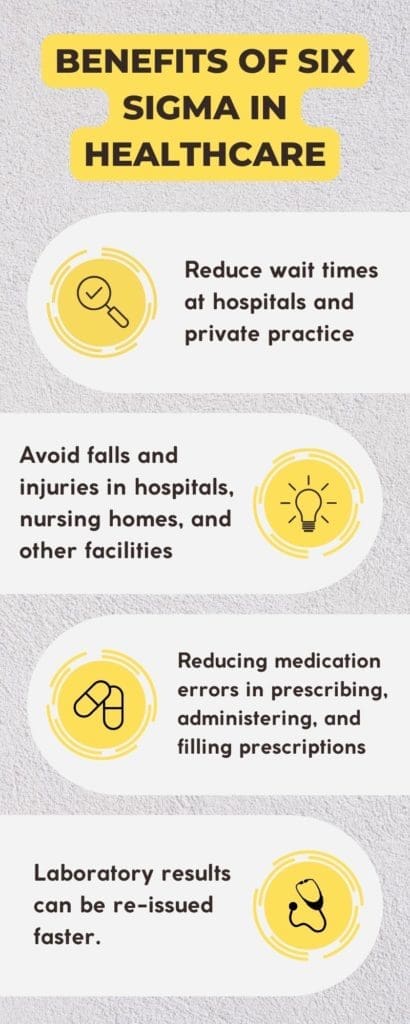- Six Sigma in Healthcare
- Six Sigma Requires Five Steps to Improve Quality
- Six Sigma Data and Facts Drive Decisions
- Six Sigma can be Used to Improve the Quality of Healthcare Services
- Job titles that commonly require LSS certifications include:
- How to Earn Certification in Lean Six Sigma Healthcare:
- Lean Six Sigma is Successfully used in Healthcare Training Settings
- Six Sigma and Healthcare: The Impacts
- Six Sigma in Healthcare: The Benefits
- Related articles
Six Sigma in Healthcare
Many hospitals and healthcare facilities have adopted Lean Six Sigma healthcare management training tools to reduce waste and improve patient care. Six Sigma principles can be used in healthcare projects to eliminate errors and variation in processes. It can also help make procedures more efficient, and less expensive, and help improve the quality of patient care.
A defect in healthcare is a condition that causes patient dissatisfaction. There are many types of defects, from the annoying, like a long wait to see the doctor to the more serious, like an incorrect diagnosis or treatment.
The HTML 6 Sigma principles can be used across a variety of industries to increase process efficiency, eliminate waste, and reduce defects. These methodologies can result in happier customers and higher revenue if they are used correctly. Defects in healthcare can not only impact revenue and customer satisfaction, but they can also make a difference in the outcome of a patient’s life.
Healthcare professionals need to use Lean Six Sigma project methods because they can reduce the risk of medical errors. The United States has more than 210,000 deaths each year due to medical errors. The healthcare industry is estimated to have lost $17.1 billion annually because of these errors.
Numerous federal agencies have tried to solve this problem at a national level by passing legislation and imposing regulations. However, healthcare professionals–whether practice managers, hospital administrators, or practitioners–can make a difference in their own organizations by employing Lean Six Sigma principles.
Six Sigma Requires Five Steps to Improve Quality
- Definition: Who are the patients and what do they need? What are the measurements of the process? What are our goals?
- Measure What will improvement look like What data will we measure our efforts? Performance metrics in healthcare organizations often include service level and cost, patient satisfaction, clinical excellence, and service quality.
- Analyze Collect data and analyze using proven tools.
- Improvement:Implement modifications are made to improve the process.
- Control:Monitor performance for improvement.
Six Sigma Data and Facts Drive Decisions
Six Sigma has been proven to improve patient care through projects by:
- Reduced errors by doctors, nurses, and technicians
- Improve lab turnaround times
- Reduce appointment wait times
- Steps to decrease in the supply chains
- Insurance claims: Accelerating reimbursement
- Improving patient outcomes
Six Sigma can be Used to Improve the Quality of Healthcare Services

- Reduce wait times at hospitals and private practice
- Avoid falls and injuries in hospitals, nursing homes, and other facilities
- Reducing medication errors in prescribing, administering, and filling prescriptions
- Laboratory results can be re-issued faster.
Six Sigma can help reduce expenses in healthcare management. Healthcare professionals can achieve these kinds of results by using proven Six Sigma or Lean methodologies. For example, the DMAIC method (Define Measure, Analyze and Improve, Control) focuses on improving processes. Check-in is one of the most important processes in a hospital setting. This is how DMAIC could simplify this process:
Define
- Identify the issues and set goals.
- Create a process map detailing each step.
Measure
- Take a look at the performance of your current check-in and collect data for each step.
- Identify bottlenecks – where is the process slowing?
Analyze
- Analyze each step’s data and look for any elements that could be simplified or eliminated.
- Identify the root cause of bottlenecks.
Improve
- Test and develop solutions to improve check-ins. Can insurance information be obtained prior to patient arrival in non-emergencies? Can nurses and doctors be more coordinated?
Control
- You can ensure that the new check in procedure is on track by regularly monitoring and documenting any improvements.
- To determine how effective the new process is over time, create a control chart.
The first step in streamlining the check-in process is to make it easier. There are many successful Lean Six Sigma examples in healthcare, from making clinical research more economical to decreasing appointment cancellations. Healthcare professionals who have Lean Six Sigma certifications will be in high demand. Lean Six Sigma training can help employees in the areas of quality management, consulting, and patient experience. They can also be trained to become leaders in healthcare management.

Job titles that commonly require LSS certifications include:
- Chief Patient Experience Officer
- Senior Director, Patient Experience
- Senior Manager, Operational Excellence
- Vice President Quality
- Director Quality
- Director Quality Management
- Associate Vice President, Strategic Process Improvement
- Quality Improvement Consultant
- Process Consultant
- Clinical Transformation Consultant
How to Earn Certification in Lean Six Sigma Healthcare:
A high-quality Lean Six Sigma certification program can help healthcare professionals advance their careers and give them a competitive edge. A Lean Six Sigma Green Belt Certificate or Six Sigma Black Belt certification are required for many leadership positions in the healthcare sector. Green Belt holders have a good understanding of LSS methods and can supervise some projects or help Six Sigma Black Belt holders who are qualified to manage large-scale projects.
Lean Six Sigma is Successfully used in Healthcare Training Settings
Patients have more information than ever about healthcare providers, and patients can now choose the provider they prefer. Healthcare organizations increasingly consider patient reviews and their perceptions to be essential factors in quality improvement. Six Sigma is the method to measure and improve these aspects.
Six Sigma and Healthcare: The Impacts
These are some examples of healthcare organizations that have adopted Six Sigma to improve their quality.
- Mount Carmel Health System – Two years of Six Sigma projects that focused on operational issues as well as business management saved $3.1 million for the healthcare system. The satisfaction levels of both employees and physicians also increased.
- Boston Medical Center – A focus on diagnostic imaging led to revenue growth of over $2.2 million and cost savings.
- Rapides Regional Medical Center: This healthcare facility used Six Sigma to reduce the number of errors in its emergency department. The hospital saw fewer patients, had a lower wait time and saved $950,000 per year.
- The Women and Infants Hospital in Rhode Island: Six Sigma was successfully implemented to standardize embryo transfer procedures. This resulted in a 35% increase in implementation rates.
- Valley Baptist Health System – The hospital increased its capacity by using Six Sigma to reduce the time it takes to perform surgery. This allowed them to take on 1,100 more cases each year and increase their potential annual income of $1.3 million.
- Yale New Haven Medical Center: Six Sigma projects were implemented in the surgical intensive-care unit. This resulted in a 75% decrease in bloodstream infections, and an estimated $1.2million in annual savings.

Six Sigma in Healthcare: The Benefits
Healthcare organizations can deliver better patient care by understanding the needs of patients and their expectations. Six Sigma has been proven to have a significant impact on healthcare operations and management. This can lead to both quality improvement and cost savings.
Six Sigma can be used to help healthcare providers find the best ways to optimize resources, reduce waste, and achieve the results they want.



















